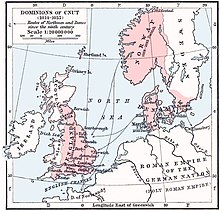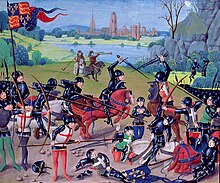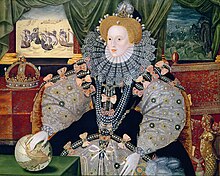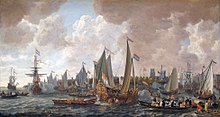Kingdom of England
Kingdom of England | |||||||||
|---|---|---|---|---|---|---|---|---|---|
| Early 10th century–1707 (1649–1660: Commonwealth) | |||||||||
| Motto: "Dieu et mon droit" (French) "God and my right"[1] (since 15th century) | |||||||||
 Location of the Kingdom, 1558–1707 (green) | |||||||||
| Capital |
| ||||||||
| Official languages | |||||||||
| Regional languages | |||||||||
| Religion | Puritanism (1646–1660) | ||||||||
| Demonym(s) | English | ||||||||
| Government |
| ||||||||
| Monarch | |||||||||
• Early 10th century–924 (first) | Edward the Elder | ||||||||
• 1702–1707 (last) | Anne[g] | ||||||||
| Legislature | Parliament | ||||||||
| House of Lords | |||||||||
| House of Commons | |||||||||
| History | |||||||||
| Early 10th century | |||||||||
| 14 October 1066 | |||||||||
| May 1169–May 1777 | |||||||||
| 15 June 1215 | |||||||||
| 1535–1542 | |||||||||
| 24 March 1603 | |||||||||
| 11 December 1688 | |||||||||
| 1 May 1707 | |||||||||
| Currency | Pound sterling | ||||||||
| |||||||||
| Today part of | |||||||||
| History of England |
|---|
 |
|
|
The Kingdom of England was a sovereign state on the island of Great Britain from the early 10th century, when it emerged from various Anglo-Saxon kingdoms, until 1 May 1707, when it united with Scotland to form the Kingdom of Great Britain, which would later become the United Kingdom. The Kingdom of England was among the most powerful states in Europe during the medieval and early modern colonial periods.
During the early tenth century, the various Anglo-Saxon kingdoms were united by
Histories of the Kingdom of England from the Norman Conquest of 1066 conventionally distinguish periods named after successive ruling dynasties: Norman/Angevin 1066–1216, Plantagenet 1216–1485, Tudor 1485–1603 and Stuart 1603–1707 (interrupted by the Interregnum of 1649–1660). Dynastically, all
The completion of the
From the accession of
Name
The Anglo-Saxons referred to themselves as the Engle or the Angelcynn, originally names of the Angles. They called their land Engla land, meaning "land of the English", by
The standard title for monarchs from
History
Anglo-Saxon England
The kingdom of England emerged from the gradual unification of the early medieval
During the Heptarchy, the most powerful king among the Anglo-Saxon kingdoms might become acknowledged as
In 886,
During the following years Northumbria repeatedly changed hands between the English kings and the Norwegian invaders, but was definitively brought under English control by

England has remained in political unity ever since. During the reign of
Norman Conquest
The peace lasted until the death of the childless Edward in January 1066. His brother-in-law was crowned
High Middle Ages
In 1092,

The Anglo-Norman invasion of Ireland took place during the late 12th century, when Anglo-Normans gradually conquered and acquired large swathes of land from the Irish, over which the Kingdom of England then claimed sovereignty, all allegedly sanctioned by the Papal bull Laudabiliter.[19] At the time, Gaelic Ireland was made up of several kingdoms, with a High King claiming lordship over most of the other kings.[20]
The
Conquest of Wales
Up until the Norman Conquest of England, Wales had remained for the most part independent of the
Edward I defeated Llywelyn ap Gruffudd, and so effectively conquered Wales, in 1282. He created the title Prince of Wales for his heir, the future Edward II, in 1301. Edward I's conquest was brutal and the subsequent repression considerable, as the magnificent Welsh castles such as Conwy, Harlech, and Caernarfon attest.[23]
Late Middle Ages

During the Hundred Years' War an
The kingdom had little time to recover before entering the Wars of the Roses (1455–1487), a series of civil wars over possession of the throne between the House of Lancaster (whose heraldic symbol was the red rose) and the House of York (whose symbol was the white rose), each led by different branches of the descendants of Edward III. The end of these wars found the throne held by the descendant of an initially illegitimate member of the House of Lancaster, married to the eldest daughter of the House of York: Henry VII and Elizabeth of York.[26]
Tudor period
Wales retained a separate legal and administrative system, which had been established by

During the 1530s, Henry VIII overthrew the power of the Catholic Church within the kingdom, replacing the pope as head of his own English Church and seizing the Catholic Church's lands, thereby facilitating the creation of a variation of Catholicism that became more Protestant over time. This had the effect of aligning England with Scotland, which also gradually adopted a Protestant religion, whereas the most important continental powers, France and Spain, remained Roman Catholic.[28]
The "Tudor conquest" (or reconquest) of Ireland' took place under the Tudor dynasty. Following a
Calais, the last remaining continental possession of the Kingdom, was lost in 1558, during the reign of Philip and Mary I. Their successor, Elizabeth I, consolidated the new and increasingly Protestant Church of England. She also began to build up the kingdom's naval strength, on the foundations Henry VIII had laid down. By 1588, her new navy was strong enough to defeat the Spanish Armada, which had sought to invade England to halt English support for the Dutch rebels and to put a Catholic monarch on the throne in her place.[30][31][32]
Early modern history
The House of Tudor ended with the death of Elizabeth I on 24 March 1603.
Civil War and Interregnum

The Stuart kings overestimated the power of the English monarchy, and were cast down by Parliament in 1645 and 1688. In the first instance,
After the
Meanwhile, relations with the Dutch Republic had deteriorated. Despite initial English support during the Dutch War of Independence against the Spanish, tensions arose as the Dutch Republic emerged as England's principal commercial and naval rival. By the mid-17th century, it had become the foremost trading nation. In response the English, alarmed by their waning competitiveness, implemented stricter trading policies to curb Dutch dominance. The First Anglo-Dutch War which followed, however, failed to resolve the commercial issues.[36][37]
In April 1653 Cromwell and the other
After an experiment with a Nominated Assembly (
Restoration and Glorious Revolution

Richard proved to be ineffectual and was unable to maintain his rule. He resigned his title and retired into obscurity. The Rump Parliament was recalled and there was a second period where the executive power lay with the Council of state. But this restoration of Commonwealth rule, similar to that before the Protectorate, proved to be unstable, and the exiled claimant,
In 1665 the unresolved commercial issues with the Dutch led to the
Following the Restoration of the monarchy in 1660, an attempt by
Union with Scotland
In the Scottish case, the attractions were partly financial and partly to do with removing English trade sanctions put in place through the Alien Act 1705. The English were more anxious about the royal succession. The death of William III in 1702 had led to the accession of his sister-in-law Anne to the thrones of England and Scotland, but her only surviving child had died in 1700, and the English Act of Settlement 1701 had given the succession to the English crown to the Protestant House of Hanover. Securing the same succession in Scotland became the primary object of English strategic thinking towards Scotland. By 1704, the Union of the Crowns was in crisis, with the Scottish Act of Security allowing for the Scottish Parliament to choose a different monarch, which could in turn lead to an independent foreign policy during a major European war.[44]
A
The English and Scottish Parliaments were merged into the
Government
Territorial divisions
The counties of England were established for administration by the Normans, in most cases based on earlier shires established by the Anglo-Saxons. They ceased to be used for administration only with the creation of the administrative counties in 1889.[47]
Unlike the partly self-governing boroughs that covered urban areas, the counties of medieval England existed primarily as a means of enforcing central government power, enabling monarchs to exercise control over local areas through their chosen representatives – originally sheriffs and later the lord-lieutenants – and their subordinate justices of the peace.[48] Counties were used initially for the administration of justice, collection of taxes and organisation of the military, and later for local government and electing parliamentary representation.[49] Some outlying counties were from time to time accorded palatine status with some military and central government functions vested in a local noble or bishop. The last such, the County Palatine of Durham, did not lose this special status until the 19th century.[50]
Although all of England was divided into shires by the time of the Norman Conquest, some counties were formed considerably later, up to the 16th century. Because of their differing origins the counties
The power of the
The
At the same time the Council of Wales was created in 1472, a
Taxation
In the Anglo-Saxon period, the geld or property tax was first levied in response to Danish invasions but later became a regular tax. The majority of the king's income derived from the royal demesne and the annual "farm" from each shire (the fixed sum paid by sheriffs for the privilege of administering and profiting from royal lands). Kings also made income from judicial fines and regulation of trade.[56] People owed the king service in the form of the trinoda necessitas—fyrd service, burh building, and bridge building.[57]
After the Conquest of 1066, the Normans continued collecting the geld regularly. They also introduced new sources of revenue based on concepts of feudalism. The king was entitled to collect a feudal aid when his eldest son was knighted, his eldest daughter married, or if the king needed to pay his own ransom. The heir to a fief was also required to pay the king a feudal relief before he could take possession of his inheritance. The king was also entitled to his vassals military service, but vassals could pay scutage instead.[58]
Military
In the Anglo-Saxon period, England had no standing army. The king and magnates retained professional household troops (see housecarl), and all free men were obligated to perform military service in the fyrd. In addition, holders of bookland were obligated to provide a certain number of men based on the number of hides they owned.[59]
After the Norman Conquest, the king's household troops remained central to any royal army. The Anglo-Saxon fyrd also remained in use. But the Normans also introduced a new feudal element to the English military. The king's
See also
- Crown Jewels of the United Kingdom – British royal regalia
- English overseas possessions – Territories ruled by Kingdom of England
- List of English monarchs – English monarchs until 1707
- Privy Council of England – Body of advisers to the sovereign of the Kingdom of England
Notes
- ^ Old English (until the 12th century), Middle English (12th-15th century), Early Modern English (from the 15th century)
- ^ Medieval Latin (until the 14th century), Renaissance Latin (from the 16th century)
- Middle Cornish(12th–16th century), Late Cornish (from the 17th century)
- ^ Old Welsh (until the 12th century), Middle Welsh (12th–14th century), Modern Welsh (from the 14th century)
- Witenagemot
- ^ Officially under a feudal system until 1660
- ^ Continued as monarch of Great Britain until her death in 1714.
- ^ The Constitution of the United Kingdom is "uncodified".
- ^ English and Scot, James insisted, should "join and coalesce together in a sincere and perfect union, as two twins bred in one belly, to love one another as no more two but one estate".[10]
- ^ See the Nine Years' War and War of the Spanish Succession.
References
- ^ "The Royal Coat of Arms". The Royal Family. 15 January 2016. Retrieved 19 November 2018.
- ^ Carey 2011, p. 41.
- ^ "King vs. Parliament in 17th century England: From Absolutism to Constitutional Monarchy, Influence on American Governing". Constituting America. 25 May 2022. Retrieved 10 October 2023.
- ^ London, 800–1216: The Shaping of a City, "...rivalry between City and government, between a commercial capital in the City and the political capital of quite a different empire in Westminster.", accessed November 2013.
- ^ "Acts of Union 1707", UK Parliament, accessed 27 January 2011.
- ^ "Making the Act of Union 1707" (PDF). Scottish Parliament. Archived from the original (PDF) on 11 May 2011. Retrieved 27 January 2011.
- ^ Stephen Harris, Race and Ethnicity in Anglo-Saxon Literature, Studies in Medieval History and Culture, Routledge, 2004, 139f.
- ^ A. L. Mayhew and Walter W. Skeat, (1888), A Concise Dictionary of Middle English From A.D. 1150 To 1580
- ^ " Anglia " (par L. Favre, 1883–1887), dans du Cange, et al., Glossarium mediae et infimae latinitatis Archived 6 February 2020 at the Wayback Machine, éd. augm., Niort : L. Favre, 1883–1887, t. 1, col. 251c.
- ^ Willson 1963, p. 250.
- ^ a b Keynes 2014, p. 534-536.
- ^ Extract from the Anglo-Saxon Chronicle. Translations available at Berkeley Digital Library Archived 25 March 2005 at the Wayback Machine and Project Gutenberg
- ^ The Anglo-Saxon Chronicle Archived 1 July 2018 at the Wayback Machine Freely licensed version at Gutenberg Project. Note: This electronic edition is a collation of material from nine diverse extant versions of the Chronicle. It contains primarily the translation of Rev. James Ingram, as published in the Everyman edition.
- ^ Asser's Life of King Alfred, ch. 83, trans. Simon Keynes and Michael Lapidge, Alfred the Great: Asser's Life of King Alfred & Other Contemporary Sources (Penguin Classics) (1984), pp. 97–98.
- ^ Vince, Alan, Saxon London: An Archaeological Investigation, The Archaeology of London series (1990).
- ^ Giles 1914, p. 114.
- ^ Douglas 1964, p. 204–205.
- ^ Ramsay 1908, p. 82–83.
- ^ Johnston, Elva. "The Irish Church, Its Reform and the English Invasion review". The Irish Times. Retrieved 26 September 2021.
- ^ Byrne, Francis John (1973). Irish Kings and High Kings. London. pp. 40–47.
{{cite book}}: CS1 maint: location missing publisher (link) - ^ Turner 2009, p. 103.
- ^ Nelson (1966), chapter 8
- ^ Prestwich 1997, p. 206.
- ^ Seward 1978, p. 260.
- ^ Mock 2011, p. 145.
- ^ Williams 1973, p. 25.
- ^ Williams 1993, p. 124.
- ^ Elton 1977, p. 185.
- ^ Grattan, Henry (1822). "Regency: Feb. 11, 1789". The Speeches of the Right Honourable Henry Grattan in the Irish, and in the Imperial Parliament. Vol. II. Longman, Hurst, Rees, Orme and Brown. p. 114. Retrieved 22 February 2016.
The act of Henry VIII., commonly called the act of annexation, proves and ascertains what the member's arguments would deny, the existence, properties, and prerogatives of the Irish crown.
- ^ Mattingly p. 401: "the defeat of the Spanish armada really was decisive"
- ^ Parker & Martin p. 5: "an unmitigated disaster"
- ^ Vego p. 148: "the decisive defeat of the Spanish armada"
- ^ John Daniel McVey. "The Union of The Crowns 1603 – 2003". Uotc.scran.ac.uk. Retrieved 25 October 2013.
- ^ "March 1649: An Act for the abolishing the Kingly Office in England and Ireland, and the Dominions thereunto belonging", Acts and Ordinances of the Interregnum, 1642–1660., London: His Majesty's Stationery Office, 1911, pp. 18–20
- ^ Bull & Seed 1998, p. 100.
- ^ Palmer 2007, p. 39–40.
- ^ Israel 1989a, pp. 207–213.
- ^ Robison & Fritze 1996, p. 147.
- ^ Gaunt 1996, p. 204.
- ^ Harris 2005, p. 47.
- ^ Palmer 2007, p. 59–60.
- ^ Troost 2005, p. 219.
- ^ Israel 1989b, p. 37-38.
- ^ Lynch 1992, p. 311.
- ^ "1 May 1707 – the Union comes into effect". UK Parliament website. 2007. Archived from the original on 19 June 2009. Retrieved 5 February 2013.
- ^ "The Irish War of Independence – A Brief Overview – The Irish Story". Archived from the original on 1 September 2021. Retrieved 1 September 2021.
- ISBN 978-0-901050-67-0.
Ancient County: Counties are geographic entities whose origins reach back into the pre-Conquest period. They were derived either from Anglo-Saxon kingdoms whose size made them suitable administrative units when England was unified in the tenth century, or as artificial creations formed from larger kingdoms. The number of 'shires' (the Anglo-Saxon term) or 'counties' (Norman term) varied in the medieval period, particularly in the north of England.
- ISBN 978-0-7190-6706-8.
- ISBN 978-0-14-017663-6.
- ^ The Durham (County Palatine) Act 1836 (6 & 7 Will 4 c 19)
- ^ Vision of Britain Archived 16 April 2017 at the Wayback Machine – Census Geographies. Retrieved 19 October 2006.
- ISBN 978-0-7478-0060-6.
- ^ "The Complete Peerage, Edition 1, Volume 3, page 375".
- ^ William Searle Holdsworth, "A History of English Law", Little, Brown, and Company, 1912, p. 502
- JSTOR 3678773.
- ^ Huscroft 2016, pp. 29–30.
- ^ Jolliffe 1961, p. 52.
- ^ Huscroft 2016, p. 90.
- ^ Huscroft 2016, p. 31.
- ^ Huscroft 2016, p. 97.
Cited works
- Bull, Stephen; Seed, Mike (1998). Bloody Preston: The Battle of Preston, 1648. Lancaster: Carnegie Publishing Ltd. ISBN 1-85936-041-6.
- ISBN 978-1-139-49409-0.
- OCLC 399137.
- ISBN 0-7131-5952-9.
- Gaunt, Peter (1996). Oliver Cromwell. Blackwell. ISBN 0-631-18356-6.
- Giles, J.A. (1914). . London: G. Bell and Sonson. p. – via Wikisource.
- Harris, Tim (2005). Restoration:Charles II and His Kingdoms 1660–1685. Allen Lane. ISBN 978-0713991918.
- Huscroft, Richard (2016). Ruling England, 1042–1217 (2nd ed.). Routledge. ISBN 978-1138786554.
- Jolliffe, J. E. A. (1961). The Constitutional History of Medieval England from the English Settlement to 1485 (4th ed.). Adams and Charles Black.
- Keynes, Simon (2014) [1st edition 1999]. "Appendix I: Rulers of the English, c. 450–1066". In Lapidge, Michael; Blair, John; Keynes, Simon; Scragg, Donald (eds.). The Wiley Blackwell Encyclopedia of Anglo-Saxon England (Second ed.). Chichester, West Sussex: Wiley Blackwell. pp. 521–538. ISBN 978-0-4706-5632-7.
- Lynch, Michael (1992). Scotland: A New History. Pimlico. pp. 311. ISBN 0-7126-9893-0.
- Mock, Steven (2011). Symbols of Defeat in the Construction of National Identity. Cambridge University Press. OCLC 1097164619.
- Nelson, Lynn H. (1966). The Normans in South Wales, 1070–1171. Austin and London: University of Texas Press.
- Palmer, M. A.J. (2007). Command at Sea: Naval Command and Control since the Sixteenth Century. Harvard University Press. ISBN 9780674041912.
- Prestwich, Michael (1997). Edward I. English Monarchs (Revised Second ed.). Yale University Press. OL 704063M.
- Ramsay, James Hill (1908). "Henry III, A.D. 1237–1241". The Dawn of the Constitution or The Reigns of Henry III and Edward I (A.D. 1216 – 1307). The Scholar's History of England: Volume IV. London: Swan Sonnenschein & Co. pp. 82–83.
- Robison, William; Fritze, Ronald H. (1996). Historical Dictionary of Stuart England, 1603–1689. Greenwood Press. p. 147. ISBN 978-0313283918.
- Seward, Desmond (1978). The Hundred Years War: The English in France, 1337–1453. New York: Atheneum.
- Troost, Wout (2005). William III, The Stadholder-king: A Political Biography. Translated by J. C. Grayson. Ashgate Publishing. ISBN 0-7546-5071-5.
- Turner, Ralph V. (2009). King John: England's Evil King?. Stroud, UK: History Press. ISBN 978-0-7524-4850-3.
- ISBN 0192852779.
- Williams, Neville (1973). The Life and Times of Henry VII. London: Weidenfeld and Nicolson. ISBN 978-0-297-76517-2.
- ISBN 978-0-2246-0572-4
Further reading
- Bartlett, Robert (2002). England under the Norman and Angevin kings: 1075–1225. Oxford University Press.
- Black, J.B. (1936). The Reign of Elizabeth, 1558–1603.
- Borman, Tracy (2015). Thomas Cromwell: The Untold Story of Henry VIII's Most Faithful Servant.
- Elton, G. R. (1955). England under the Tudors. Methuen.
- Ellis, Steven G. (2014). Ireland in the age of the Tudors, 1447–1603: English expansion and the end of Gaelic rule. Routledge.
- Guy, John (2013). The Tudors: a very short introduction. Oxford University Press.
- Harriss, G.L. (2005). Shaping the nation: England 1360–1461. Oxford University Press.
- Israel, Jonathan (1989a). Dutch Primacy in World Trade, 1585-1740 (E-book ed.). Clarendon Press. ISBN 9780191591822.
- Israel, Jonathan (1989b). The Dutch Republic and the 'Glorious Revolution' of 1688/89 in England. Greenwich: Trustees National Maritime Museum. pp. 31–44. ISBN 978-0948065033.
- Jacob, E.F. (1961). The Fifteenth Century, 1399–1485. Oxford History of England.
- Jenkins, Elizabeth (1964). Elizabeth the Great. Time Incorporated.
- Jones, J. Gwynfor (1989). Wales and the Tudor state: government, religious change and the social order, 1534–1603. University of Wales Press.
- Levin, Carole (2013). The heart and stomach of a king: Elizabeth I and the politics of sex and power. University of Pennsylvania Press.
- Loades, David Michael(1999). Politics and nation: England 1450–1660. Wiley-Blackwell.
- Loades, David Michael(1997). Power in Tudor England.
- McCaffrey, Wallace. Elizabeth I.
- McKisack, May (1959). The Fourteenth Century, 1307–1399. Oxford History of England.
- Neale, J.E.(1957). Queen Elizabeth I: a biography.
- Penn, Thomas (2012). Winter king: Henry VII and the dawn of Tudor England.
- Powicke, Maurice(1962). The Thirteenth Century, 1216–1307. Oxford History of England.
- Ridley, Jasper G. (1985). Henry VIII.
- Clayton, F. David Roberts; Bisson, Douglas (2016). A History of England, Volume 1: Prehistory to 1714. Routledge.
- Thomson, John A.F. (2014). The Transformation of Medieval England 1370–1529. Routledge.
- Williams, Penry (1995). The Later Tudors: England, 1547–1603. Oxford University Press.



